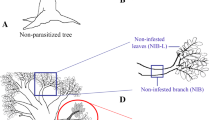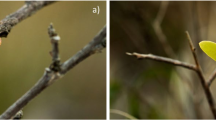Abstract
Mistletoes are adapted to parasitize aerial parts of their hosts, and they have a great morphological variation and wide global distribution. Their effects on hosts were more or less investigated; however, no comparative interspecific study had been reported. This study aimed to compare three locale mistletoes Phragmanthera austroarabica, Viscum schimperi, and Plicosepalus acacia based on photosynthetic activity, major-trace- and ultra-trace elements’ distribution and metabolome profiling. P. acacia exhibited the highest net photosynthetic assimilation rate (3.3-folds), water use efficiency (5.5-folds), and accumulated major elements (44Ca, 24Mg, and 23Na). Equally, the untargeted metabolomic method showed a substantial difference in metabolome profiling, with P. acacia being the lesser accumulative of major metabolites than P. austroarabica and V. schimperi. Based on the few identified common metabolite analysis, P. acacia had the ability to avoid the accumulation of the pollutant mono(2-ethylhexyl) phthalate which, P. austroarabica and V. schimperi, cannot do. Equally, P. acacia had more defence metabolites against stressors than the other mistletoes. Accordingly, P. acacia displayed higher potentialities to be more vigor and more adapted to the parasitism’s life than P. austroarabica and V. schimperi.





Similar content being viewed by others
Data availability
The data that support the findings of this study are available on request from the corresponding author.
References
Anselmo-Moreira F, Teixeira-Costa L, Ceccantini G, Furlan CM (2019) Mistletoe effects on the host tree Tapirira guianensis: insights from primary and secondary metabolites. Chemoecology 29:11–24
Arruda R, Lunardelli C, Kitagawa C, Caires CS, Teodoro GS, Mourão FA (2013) Two mistletoes are too many? Interspecific occurrence of mistletoes on the same host tree. Acta Bot Bras 27:226–230
Bertin MJ, Zimba PV, Beauchesne KR, Huncik KM, Moeller PDR (2012) Identification of toxic fatty acid amides isolated from the harmful alga Prymnesium parvum carter. Harmful Algae 20:111–116
Cheng Z, Sun H, Sidhu HS, Sy ND, Gan J (2020) Metabolism of mono-(2-ethylhexyl) phthalate in Arabidopsis thaliana: exploration of metabolic pathways by deuterium labeling. Environ Pollut 265:1148866
Devkota MP, Joshi GP, Parajuli P (2010) Diversity, distribution and host range of mistletoe in protected and unprotected areas of central Nepal Himalayas. Banko Janakari 20:14–10
Ehleringer JR, Marshall JD (1995) Water relations. In: Press MC, Graves JD (eds) Parasitic plants. Chapman & Hall, London
Enemor VHA, Oguazu CE, Odiakosa AU, Okafor SC (2019) Evaluation of the medicinal proprieties and possible nutrient composition of Citrullus lanatus (watermekon) seeds. Res J Med Plants 13:129–135
Escher P, Rennenberg H (2006) Influx of double labelled glutamine into mistletoes (Viscum album) from the xylem sap of its host (Abies alba). Plant Physiol Biochem 44:880–884
Escher P, Eiblmeier M, Hetzger I, Rennenberg H (2004) Seasonal and spatial variation of reduced sulphur compounds in mistletoes (Viscum album) and the xylem sap of its hosts (Populus × euramericana and Abies alba). Physiol Plant 117:72–78
Fahmy GM (2013) Ecophysiology of the holoparasitic angiosperm Cistanche phelypaea (Orobancaceae) in a coastal salt marsh. Turk J Bot 37:908–919
Flowers TJ, Colmer TD (2008) Salinity tolerance in halophytes. New Phytol 179:945–963
Gao F, Hu W, Li Y, Shen H, Hu J (2017) Mono-2-ethylhexyl phthalate inhibits human extravillous trophoblast invasion via the PPARy pathway. Toxicol Appl Pharmacol 327:23–29
García-García JD, Anguiano-Cabello JC, Arredondo-Valdés R et al (2021) Phytochemical characterization of Phoradendron bollanum and Viscum album subs. austriacum as Mexican mistletoe plants with antimicrobial activity. Plants (basel) 26:1299
Glatzel G, Geils BW (2009) Mistletoe ecophysiology: host–parasite interactions. Botany 87:10–15
Hamberger A, Stenhagen G (2003) Erucamide as a modulator of water balance: new function of a fatty acid amide. Neurochem Res 28:177–185
Hibberd JM, Jeschke WD (2001) Solute flux into parasitic plants. J Exp Bot 52:2043–2049
Hibberd JM, Bungard RA, Press MC, Jeschke WD, Scholes JD, Quick WP (1998) Localization of photosynthetic metabolism in the parasitic angiosperm Cuscuta reflexa. Planta 205:506–513
Kamar V, Dağalp R, Taştekin M (2018) Determination of heavy metals in almonds and mistletoe as a parasite growing on the almond tree using ICP-OES or ICP-MS. Biol Trace Elem Res 185:226–235
Kim CR, Kim HS, Choi SJ, Kim JK, Gim MC, Kim YJ, Shin DH (2018) Erucamide from radish leaves has an inhibitory effect against acethylcholinesterase and prevents memory deficit induced by trimethyltin. J Med Food 21:769–776
Klamerus-Iwan A, Van Stan J (2022) Rainfall interception by common mistletoe (Viscum album L. ssp. Album): an additional water loss from infected forests. Ecohydrology 2022:1
Koenig WD, Knops JMH, Carmen WJ, Pesendorfer MB, Dickinson JL (2018) Effects of mistletoe (Phoradendron villosum) on California oaks. Biol Lett 14:20180240
Kuijt J (1969) The biology of parasitic flowering plants. University of California Press, London
Lázaro-González A, Hódar JA, Zamora R (2019) Mistletoe versus host pine: does increased parasite load alter the host chemical profile? J Chem Ecol 45:95–105
Le QV, Tennakoon KU, Metali F, Lim LBL, Bolin JF (2016) Ecophysiological responses of mistletoe Dendrophthoe curvata (Loranthaceae) to varying environmental parameters. J Trop for Sci 28:59–67
Li T, Yong-nian N, Lan G, Li L (2008) Simultaneous determination of trace elements in mistletoe by ICP-AES. Spectrosc Spect Anal 28:1157–1159
Llugany M, Lombini A, Dinelli E, Poschenrieder C, Barceló J (2009) Transfer of selected mineral nutrients and trace elements in the host–hemiparasite association, Cistus-Odontites lutea, growing on and off metal-polluted sites. Plant Biol 11:170–178
Lu YF, Zhou YR, Nakai S, Hosomi M, Zhang H, Kronzucker HJ et al (2014) Stimulation of nitrogen removal in the rhizosphere of aquatic duckweed by root exudate components. Planta 239:591–603
Lüttge U (2008) Physiological ecology of tropical plants, 2nd edn. Springer, Berlin
Lüttge U, Haridasan M, Fernandes GW, deMattos EA, Trimborn P, Franco AC, Caldas LS, Ziegler H (1998) Photosynthesis in mistletoes in relation to their hosts at various sites in tropical Brazil. Trees 12:167–174
Machado MA, Zetsche K (1990) A structural, functional and molecular analysis of plastids of the holoparasites Cuscuta reflexa and Cuscuta europaea. Planta 181:91–96
Maes WH, Huete AR, Avino M, Boer MM, Dehaan R, Pendall E, Griebel A, Steppe K (2018) Can UAV-based infrared thermography be used to study plant-parasite interactions between mistletoe and eucalypt trees? Remote Sens 10:2–16
Majeed M, Pirzadah TB, Mir MA, Hakeem KR, Alharby HF, Alsamadany H, Bamagoos AA, Rehman RU (2021) Comparative study on phytochemical profile and antioxidant activity of an epiphyte, Viscum album L. (White berry mistletoe), derived from different host trees. Plants 10:1191
Mathiasen RL, Nickrent DL, Shaw DC, Watson DM (2008) Mistletoes: pathology, systematics, ecology, and management. Plant Dis 92:988–1006
Medel R, Vergara E, Silva A, Kalin-Arroyo M (2004) Effects of vector behavior and host resistance on mistletoe aggregation. Ecology 85:120–126
Muche M, Muasya AM, Tsegay BA (2022) Biology and resource acquisition of mistletoes, and the defense responses of host plants. Ecol Process 11:24
Mudgal G, Kaur J, Chand K, Parashar M, Dhar SK, Singh GB, Gururani MA (2022) Mitigating the mistletoe menace: biotechnological and smart management approaches. Biology 11:1645
Nickrent DL (2011) Santalales (including mistletoes). In: Encyclopaedia of life sciences (ELS). Wiley, Chichester
Okubamichael DY, Griffiths ME, Ward D (2011) Host specificity, nutrient and water dynamics of the mistletoe Viscum rotundifolium and its potential host species in the Kalahari of South Africa. J Arid Environ 75:898–902
Ornelas JF, Vásquez-Aguilar AA (2023) Host-mediated effects on fruit size variation of the hemiparasitic mistletoe Psittacanthus schiedeanus (Loranthaceae). Acta Bot Mex 130:e2134
Ornelas JF, Gandara E, Vasquez-Aguilar AA, Ramirez-Barahona S, Ortiz-Rodriguez AE, Gonzalez C, Mejia-Saules MT, Ruiz-Sanchez E (2016) A mistletoe tale: postglacial invasion of Psittacanthus schiedeanus (Loranthaceae) to Mesoamerican cloud forests revealed by molecular data and species distribution modeling. BMC Evol Biol 16:78
Pate JS (1995) Mineral relationships of parasitic plants and their hosts. In: Press MC, Graves JD (eds) Parasitic plants. Chapman and Hall, London, pp 80–102
Pohanka M (2019) Antidotes against methanol poisoning: a review. Med Chem 19:1126–1133
Press MC, Smith S, Stewart GR (1991) Carbon acquisition and assimilation in parasitic plants. Funct Ecol 5:278–283
Rashid T, Chen J, McLeod P (2013) Toxicity of newly isolated piperideine alkaloids from the red imported fire ant, Solenopsis invicta Buren, against the green peach aphid, Myzus persicae (Sulzer). Adv Enthomol 1:20–23
Rist L, Shaanker RU, Ghazoul J (2011) The spatial distribution of mistletoe in a Southern Indian tropical forest at multiple scales. Biotropica 43:50–57
Scalon MC, Rossatto DR, Chaves Bicalho FM, Franco AC (2016) Leaf morphophysiology of a neotropical mistletoe is shaped by seasonal patterns of host leaf phenology. Oecologia 180:1103–1112
Schulze ED, Ehleringer JR (1984) The effect of nitrogen supply on growth and water use efficiency of xylem-tapping mistletoes. Planta 162:268–275
Schulze ED, Turner NC, Glatzel G (1984) Carbon, water and nutrient relations of two mistletoes and their hosts: a hypothesis. Plant Cell Environ 7:293–299
Smith S, Stewart GR (1990) Effect of potassium levels on the stomatal behaviour of the hemiparasite Striga hermonthica. Plant Physiol 94:1472–1476
Strong GL, Bannister P, Burritt D (2000) Are mistletoes shade plants? CO2 assimilation and chlorophyll fluorescence of temperate mistletoes and their hosts. Ann Bot 85:511–519
Sun L, Lu YF, Kronzucker HJ, Shi WM (2016) Quantification and enzyme targets of fatty acid amides from duckweed root exudates involved in the stimulation of denitrification. J Plant Physiol 198:81–88
Tamilmani E, Radhakrishnan R, Sankaran K (2018) 13-Docosenamide release by bacteria in response to glucose during growth-fluorescein quenching and clinical application. Appl Microbiol Biotechnol 102:6673–6685
Tang CS (1979) New macrocyclic, delta1-piperideine alkaloids from papaya leaves: dehydrocarpaine I and II. Phytochemistry 18:651–652
Tennakoon KU, Pate JS, Fineran BA (1997) Growth and partitioning of carbon and fixed nitrogen in the shrub legume Acacia littorea in the presence or absence of the root hemiparasite Olax phyllanthi. J Exp Bot 48:1047–1060
Těšitel J (2016) Functional biology of parasitic plants: a review. Plant Ecol Evol 149:5–20
Thomas S, Ricke WA, Li L (2023) Toxicoproteomics of mono-(2-ethylexyl) phthalate and perfluorooctanesulfonic acid in models of prostatic diseases. Chem Res Toxicol 366:251–259
Türe C, Böcük H, Asan Z (2010) Nutritional relationships between hemi-parasitic mistletoe and some of its deciduous hosts in different habitats. Biologia 65:859–867
Vidal-Russell R, Nickrent DL (2008) Evolutionary relationship in the showy mistletoe family (Loranthaceae). Am J Bot 95:1015–1029
Vurro E, Ruotolo R, Ottonello S, Elviri L, Maffini M, Falasca G, Zanella L, Altamura MM, di Toppi LS (2011) Phytochelatins govern zinc/copper homeostasis and cadmium detoxification in Cuscuta campestris parasitizing Daucus carota. Environ Exp Bot 72:26–33
Wang W, Craig ZR, Basavarajappa MS, Hafner S, Flaws JA (2012) Mono-(2-ethylexyl) phthalate induces oxidative stress and inhibits growth of mouse ovarian antral follicles. Biol Reprod 87:152
Wiesenborn DW (2016) Conspecific pollen loads on insects visiting female flowers on parasitic Phoradendron californicum (Viscaceae). West n Am Nat 76:113–212
Xie Y, Peng Q, Ji Y, Xie A, Yang L, Mu S, Li Z, He T, Xiao Y, Zhao J, Zhang Q (2021) Isolation and identification of antibacterial bioactive compounds from Bacillus megaterium L2. Front Microbiol 12:645484
Yoshida S, Cui S, Ichihashi Y, Shirasu K (2016) The haustorium, a specialized invasive organ in parasitic plants. Annu Rev Plant Biol 67:643–667
Zhang X, Chingin K, Zhong D, Luo L, Franhevich V, Chen H (2018) Deciphering the chemical origin of the semen-like floral scents in three angiosperm plants. Phytochemistry 145:137–145
Funding
The author wishes to thank King Khalid University for funding this work (Award No. R. G. P. 1/20/43).
Author information
Authors and Affiliations
Contributions
The author performed the study conception and design.
Corresponding author
Ethics declarations
Conflict of interest
The author declares that he have no competing financial interests.
Additional information
Communicated by Günther Raspotnig.
Rights and permissions
Springer Nature or its licensor (e.g. a society or other partner) holds exclusive rights to this article under a publishing agreement with the author(s) or other rightsholder(s); author self-archiving of the accepted manuscript version of this article is solely governed by the terms of such publishing agreement and applicable law.
About this article
Cite this article
Barhoumi, Z. Comparative study of three local mistletoes: insights from photosynthetic, ionomic, and metabolomic attributes. Chemoecology 34, 13–25 (2024). https://doi.org/10.1007/s00049-024-00397-3
Received:
Accepted:
Published:
Issue Date:
DOI: https://doi.org/10.1007/s00049-024-00397-3




